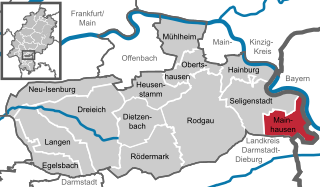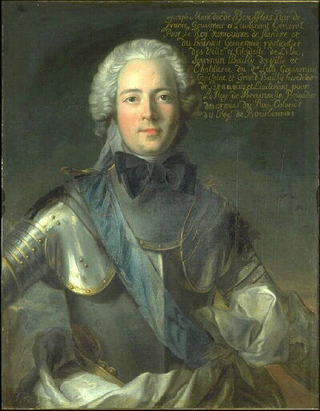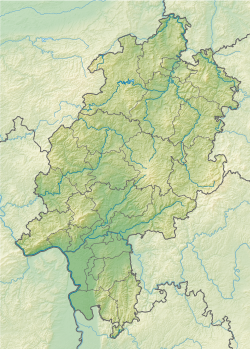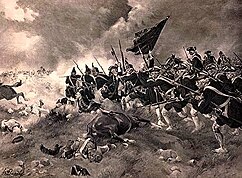
The War of the Austrian Succession was a European conflict fought between 1740 and 1748, primarily in Central Europe, the Austrian Netherlands, Italy, the Atlantic Ocean and Mediterranean Sea. Related conflicts include King George's War in North America, the War of Jenkins' Ear, the First Carnatic War, and the First and Second Silesian Wars.

The Battle of Fontenoy took place on 11 May 1745 during the War of the Austrian Succession, near Tournai, then part of the Austrian Netherlands, now in Belgium. A French army of 50,000 under Marshal Saxe defeated a Pragmatic Army of roughly the same size, led by the Duke of Cumberland.

The Silesian Wars were three wars fought in the mid-18th century between Prussia and Habsburg Austria for control of the Central European region of Silesia. The First (1740–1742) and Second (1744–1745) Silesian Wars formed parts of the wider War of the Austrian Succession, in which Prussia was a member of a coalition seeking territorial gain at Austria's expense. The Third Silesian War (1756–1763) was a theatre of the global Seven Years' War, in which Austria in turn led a coalition of powers aiming to seize Prussian territory.

The Battle of Mollwitz was fought by Prussia and Austria on 10 April 1741, during the First Silesian War. It was the first battle of the new Prussian King Frederick II, in which both sides made numerous military blunders and King Frederick II of Prussia fled the battlefield, but the Prussian Army still managed to attain victory. This battle cemented Frederick's authority over the newly conquered territory of Silesia and gave him valuable military experience.

The Battle of Chotusitz, or Chotusice, sometimes called the Battle of Čáslav, took place on 17 May 1742, in Bohemia, now the Czech Republic; it was part of the 1740 to 1742 First Silesian War, itself a subsidiary of the wider War of the Austrian Succession.

Adrien Maurice de Noailles, 3rd Duke of Noailles was a French nobleman and soldier.

Karlstein am Main is a municipality in the Aschaffenburg district in the Regierungsbezirk of Lower Franconia (Unterfranken) in Bavaria, Germany. It is the westernmost settlement in Bavaria. Karlstein's Ortsteile are Dettingen and Großwelzheim, the former being notable as the site of the Battle of Dettingen during the War of the Austrian Succession. In the 20th century, the town was the site of the, now decommissioned, Großwelzheim Nuclear Power Plant.

The Battle of Rocoux took place on 11 October 1746 during the War of the Austrian Succession, at Rocourt, near Liège in the Prince-Bishopric of Liège, now modern Belgium. It was fought between a French army under Marshal Saxe and a combined British, Dutch, German and Austrian force led by Charles of Lorraine, John Ligonier and Prince Waldeck.

The Battle of Lauffeld, variously known as Lafelt, Laffeld, Lawfeld, Lawfeldt, Maastricht, or Val, took place on 2 July 1747, between Tongeren in modern Belgium, and the Dutch city of Maastricht. Part of the War of the Austrian Succession, a French army of 80,000 under Marshal Saxe defeated a Pragmatic Army of 120,000, led by the Duke of Cumberland.

Mainhausen is a municipality of over 9,000 in the Offenbach district in the Regierungsbezirk of Darmstadt in Hesse, Germany.

Louis de Gramont, 6th Duke of Gramont was Duke of Gramont and a French general in the War of Austrian Succession.

The Te Deum for the Victory at the Battle of Dettingen in D major, HWV 283, is the fifth and last setting by George Frideric Handel of the 4th-century Ambrosian hymn, Te Deum, or We Praise Thee, O God. He wrote it in 1743, only a month after the battle itself, during which Britain and its allies Hannover and Austria soundly routed the French.

The Fall of Ghent occurred on 15 July 1745 during the War of the Austrian Succession when a 5,000 strong French force under Ulrich Frédéric Woldemar, Comte de Lowendal surprised and captured the town of Ghent in the Austrian Netherlands. The Allied garrison offered little resistance.

The French Royal Army was the principal land force of the Kingdom of France. It served the Bourbon dynasty from the reign of Louis XIV in the mid-17th century to that of Charles X in the 19th, with an interlude from 1792 to 1814 and another during the Hundred Days in 1815. It was permanently dissolved following the July Revolution in 1830. The French Royal Army became a model for the new regimental system that was to be imitated throughout Europe from the mid-17th century onward. It was regarded as Europe's greatest military force for much of its existence.

Lieutenant-General Sir James Campbell, KB was a Scottish professional soldier, Member of Parliament for Ayrshire from 1727 to 1741, and Governor of Edinburgh Castle from 1738 to 1745.

The Pragmatic Army was an army which served during the War of the Austrian Succession. It was formed in 1743 by George II, who was both King of Great Britain and Elector of Hanover, and consisted of a mixture of British, Hanoverian, and Austrian forces. It was designed to uphold the Pragmatic Sanction in support of George's ally Maria Theresa of Austria and took its name from this.

Events from the year 1741 in Austria

The Hanoverian Army was the standing army of the Electorate of Hanover from the seventeenth century onwards. From 1692 to 1803 it acted in defence of the electorate. Following the Hanoverian Succession of 1714, this was in conjunction with the British Army with which it shared a monarch. Hanoverian troops fought in the War of the Austrian Succession, Seven Years' War and American War of Independence during the eighteenth century.
The battle of Prague (1741) was a successful French capture of the Austrian city Prague.

Joseph Marie de Boufflers, 2nd Duke of Boufflers was a French nobleman and senior military officer.























